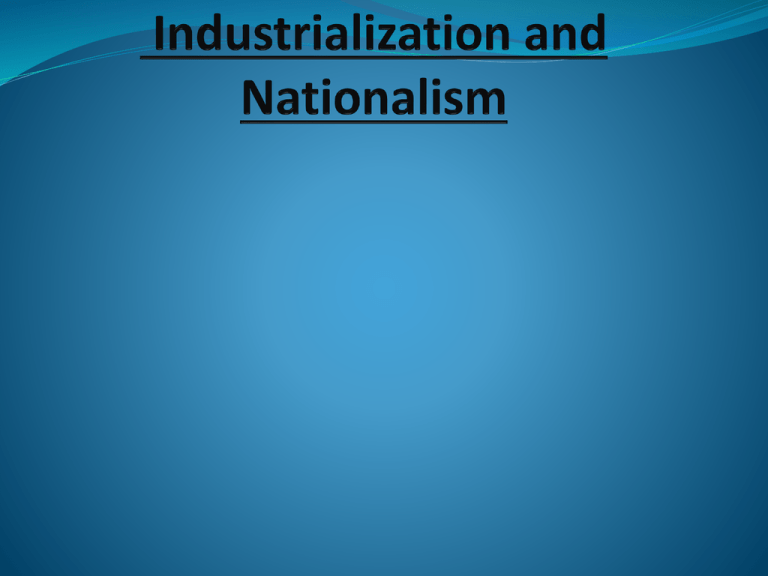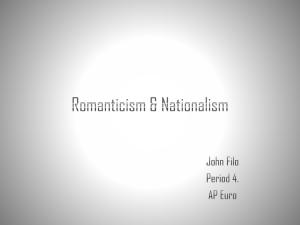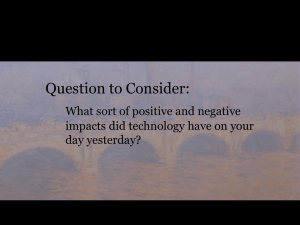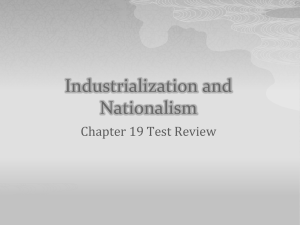Chapter 19: Industrialization and Nationalism
advertisement

Section 1: The Industrial Revolution Section 1: The Industrial Revolution The Industrial Revolution in Great Britain 1780’s Starting place Agrarian revolution Population growth Enclosure movement laws Britain had a ready supply capital Entrepreneurs –laissez-faire economy Supply of markets – British colonies Section 1: The Industrial Revolution Changes in Cotton Production Two step process: Spinners Weavers Cottage Industries Technological advancements Flying Shuttle Spinning Jenny – James Hargreaves Water-powered loom Edmund Cartwright Bring the workers to the machines Steam engine – James Watt Production increases Section 1: The Industrial Revolution The Coal and Iron Industries Coal – Fuel Iron Industry Iron ore Henry Cort –puddling British iron industry booms The New Factories New labor system Discipline of the workers Railroads Richard Trevithick George Stephenson – Blucher Stockton & Darlington – Manchester to Liverpool Rocket Railroads economic impact New jobs Less expensive transportation Larger markets More sales mean more factories Profits – reinvestment in new machines Economic growth Section 1: The Industrial Revolution The Spread of Industrialization Europe Belgium, France and Germany North America Roads and canals Robert Fulton –Clermont Railroad Labor Factory owners Section 1: The Industrial Revolution Social Impact in Europe Population and Urban Growth Population in Europe 1750 – 140 million 1850 – 266 million Key – decline in death rate Urbanization Famine and poverty Enclosure laws and industrialization Large cities Poor conditions – urban reformers The Industrial Middle Class Industrial Capitalism New middle class group Industrialists were people who built the factories, bought the machines, and developed the markets – they had the initiative, vision, ambition and greed Section 1: The Industrial Revolution The Industrial Working Class Poor working conditions Long hours No security of employment No minimum wage Coal Mines Dangerous conditions Cotton Mills Worst conditions Michael Saddler Factory Act of 1833 Women Employment of women and children - cottage industries Section 1: The Industrial Revolution Early Socialism Reformers Socialism Public ownership Ideal society Utopian Socialists Karl Marx Robert Owen Socialist New Lanark, Scotland U.S. – New Harmony, Indiana Section 2: Reaction and Revolution Section 2: Reaction and Revolution The Congress of Vienna (1814) Restore old order The Great Powers Prince Klemens von Metternich Monarchs Balance of Power Territorial changes Keep any one power Conservatism social stability political authority keep order Anti The Concert of Europe Principle of Intervention the right to send armies Great Britain Section 2: Reaction and Revolution Forces of Change Liberalism Enlightenment Protection of civil liberties Bill of Rights Constitutionalism Representative assembly Did not believe in democracy “men of property” Liberalism = Middle class men Nationalism Part of a community defined by a distinctive language, common institution, and customs French Revolution Nationalism was threat to the existing political order Revolutionary Outbursts (Led by liberals and nationalists) France Charles X in 1830 Constitutional monarchy Louis Philippe Belgium (1830) Nationalism Dutch in 1815 Independent state Poland and Italy Poland from Russia Italy from Austria Section 2: Reaction and Revolution The Revolutions of 1848 Another French Revolution Economic problems Louis Philippe Monarchy overthrown in 1848 November 4, 1848 38 independent German states Frankfort Assembly Revolutions in Central Europe Austrian Empire Second Republic Single legislature & President Charles Louis Napoleon Bonaparte – Louis-Napoleon Trouble in the German States The German Confederation Wanted France to become a republic Constitutional assembly Universal Male Suffrage A Multinational State Hapsburg Dynasty March 1848 Demonstrations Metternich Vienna In Bohemia, the Czechs Revolts in the Italian States 9 states in Italy Kingdom of Piedmont – north The Two Sicilies (Naples and Sicily) The Papal States A number of small states Lombardi and Venetia – Northern Province – controlled by Austria In 1848 – revolts By 1849 Section 3: National Unification and Nationalism Section 3: National Unification and Nationalism Toward National Unification Breakdown of the Concert of Europe The Crimean War Russia and Ottoman Empire Russia needs a warm water port 1853 – Moldavia and Walachia Great Britain and France Treaty of Paris 1856 Concert of Europe Italian Unification Kingdom of Piedmont Royal House of Savoy ruled here Island of Sardinia, Nice, and Savoy King Victor Emmanuel II Camillo di Cavour Following the war – Nice and Savoy Lombardy Venetia Giuseppe Garibaldi – Red Shirts Garibaldi –The Two Sicilies (Sicily and Naples) King Victor Emmanuel II Austro-Prussian War of 1866 Franco-Prussian War Section 3: National Unification and Nationalism German Unification Prussia King William I Otto von Bismarck “realpolitik” Denmark Austria Prussia – North German Confederation Franco-Prussian War 1870 Peace Treaty Southern German states France 5 Billion Francs Alsace and Lorraine Hall of Mirrors in the Palace of Versailles William I Kaiser of the Second German Empire Section 3: National Unification and Nationalism Nationalism and Reform in Europe Great Britain Parliament avoids revolution Queen Victoria (1837-1901) France Louis-Napoleon Plebiscite Napoleon III The Austrian Empire Nationalism was a problem for them Compromise of 1867 Created a duel monarchy of Austria-Hungary Vienna, Austria and Budapest, Hungary Francis Joseph Russia Crimean War Czar Alexander II Emancipation Edict Alexander in 1881 His son Alexander III Trans-Siberian Railroad Section 3: National Unification and Nationalism Nationalism in the United States US Constitution Two factions Federalists Republicans War of 1812 Slave trade ended in 1808 Slavery 4 million South’s economy was based on cotton Abolitionism Eli Whitney- Cotton Gin Movement to end slavery Fredrick Douglas President Abraham Lincoln Election of 1860 – Lincoln December 20, 1860 – South Carolina – voted to secede February 1861 - 6 more Confederate States of America 4 more states seceded The American Civil War (1861-1865) Lincoln’s Emancipation Proclamation Confederate forces surrendered on April 9, 1865 Section 4: Romanticism and Realism Section 4: Romanticism and Realism Romanticism 1700’s a new intellectual movement feelings, emotion, and imagination Valued individualism Loved the past – Middle Ages Romanticism in Art and Music Romantic Artists shared two features: Inner feelings Vision and imagination Eugene Delacroix “a painting should be a feast for the eyes” Liberty Leading the People The Lion Hunt Music Ludwig van Beethoven Classical and romantic music Third Symphony Section 4: Romanticism and Realism Romanticism in Literature Sir Walter Scott Gothic Literature Ivanhoe Mary Shelley’s – Frankenstein Edgar Allen Poe’s short stories of horror Poetry Was the ideal art form William Wordsworth Critical of science William Blake – poet and artist Songs of Innocence Songs of Experience Section 4: Romanticism and Realism New Age of Science New Discoveries Louis Pasteur Dmitry Mendeleyev Michael Faraday Secularization Charles Darwin On the Origin of Species by Means of Natural Selection Principle of Organic Evolution Natural Selection Survival of the fittest The Decent of Man Controversial Section 4: Romanticism and Realism Realism Realism in Literature Gustave Flaubert Madame Bovary Charles Dickens Oliver Twist David Copperfield Realism in Art Gustave Courbet portray scenes from everyday life “ I have never seen either angels or goddesses, so I am not interested in painting them”





![“The Progress of invention is really a threat [to monarchy]. Whenever](http://s2.studylib.net/store/data/005328855_1-dcf2226918c1b7efad661cb19485529d-300x300.png)


